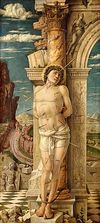Italian Renaissance Flashcards
(89 cards)
Renaissance
means “rebirth” (following the original birth of civilization)
origin of Renaissance
Florence
Florence
origin of Renaissance
small city in Italy
first city in Europe to recover from Plague
causes of Italian Renaissance
humanism
plague
fall of Constantinople (brain drain)
humanism
belief that all human beings have value
message spread by Petrarch
education has ability to improve human condition
Plague
disease from Asia which quickly killed many in Europe
spread extremely easily and quickly
effects of Plague on Europe
killed 30% of population
effects of Plague on Florence
killed 70% of Florence
effects of Plague on economy
immediately hurt economy by killing many workers
gradually helped economy as population recovered
growth of middle class allows people to spend money on more than just necessities
fall of Constantinople
invasion of Roman capital by Persians
caused a brain drain to Florence
brain drain
emigration of educated people from a particular city or area
effects of fall of Constantinople
helped Florence’s economy

known as “Lamentation” or “Lamentation of Christ”
painted by Giotto
from Italian Renaissance
blue sky was unique
example of psychological realism
psychological realism
style of art which depicts emotions on faces

known as “The Trinity” or “The Holy Trinity”
painted by Masaccio
from Italian Renaissance
example of use of perspective
people who bought the painting can be seen
perspective
art tool used to create illusion of 3-dimensional space on a 2-dimensional surface

known as “Saint Sebastian”
painted by Andrea Mantegna
from Italian Renaissance
arrows symbolize how it was believed God gave people Plague
Saint Sebastian
patron saint of the Plague
executed by arrows
color which Mary wears in art
blue
symbolizes faithfulness
color which Mary Magdeline wears in art
red
symbolizes sin
color which John wears in art
red
symbolizes devout faith

known as “David”
painted by Andrea del Castagno
from Italian Renaissance
shows both before and after
painted on shield (never used in battle)

known as “Birth of Venus”
painted by Sandra Botecelli
from Italian Renaissance
first naked painting of Italian Renaissance
flying people are swooping in to clothe Venus


























